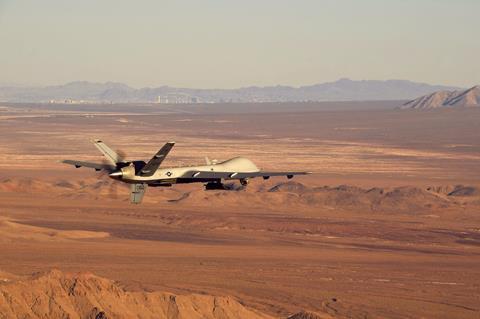General Atomics Aeronautical Systems has successfully tested on the ground a space laser communication system that it intends to use to securely transfer data between its MQ-9 Reaper unmanned air vehicle (UAV) and satellites.
From an optical observatory located on Tenerife in the Canary Islands in the Atlantic Ocean, the company’s Airborne Laser Communication System recently established a link with a satellite in geo-synchronous Earth orbit, it says on 20 February. The test was done in partnership with Tesat-Spacecom using that company’s GEO Laser Communication Terminal, the LCT 135.

“This was the first demonstration of an air-to-space lasercom system with size, weight and power that is compatible with a medium-altitude, long-endurance [UAV],” says General Atomics.
The company says it used internal funds over the past five years to develop the laser communications system. Using a laser, instead of a microwave broadcast such as Ku-band, creates a lower probability that an adversary could intercept or detect a signal being sent or received by an MQ-9.
“This test was a critical step towards enabling our aircraft with a high-bandwidth communication system that cannot be jammed or detected by an adversary,” says Linden Blue, chief executive officer of General Atomics. “[Airborne Laser Communication System] allows a new generation of high-performance sensors by breaking the data bottleneck of current [radio frequency] SATCOM technology.”
General Atomics says its laser has 300 times the data-carrying capacity of conventional radio frequency SATCOM systems. The Airborne Laser Communication System will also be able to operate as a gateway to the US military’s Joint Aerial Network for forward-deployed forces, says the company.
The new laser communications systems comes as the US Air Force is pushing forward the development of its Advanced Battle Management System, a sort of internet-of-things network that is supposed to enable faster and closer collaboration between aircraft, UAVs satellites, tanks and ships.
Additionally, Pentagon’s creation of the Space Force in December 2019 was partly intended to increase the USA’s investment in space-based communication.





























